Historic Nottingham - Part 5 - To The Lace Market
w/e 08 July 2007
All this week's pictures were taken
with a Kodak DX6490
Our walk through Historic Nottingham began at the
Castle and continued via the Brewhouse Yard Museum and the Nottingham
Canal to London Road where at "The Island" we resume
in this the fifth part. This marks the approximate halfway point
and we now start to head back towards the Castle through the
Lace Market.
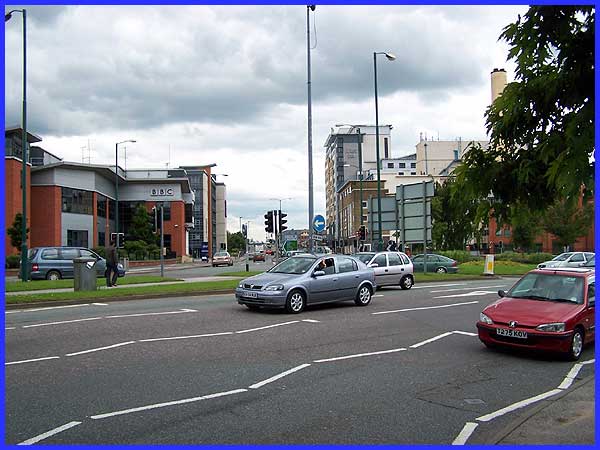
"The Island" is not only the traffic island (on the
right of the picture above) where Canal Street meets London Road
but also includes the site where the BBC studios now stand. This
was formerly the site of a factory on Island Street belonging
to the pharmaceutical giant, Boots and the area was known as
Boots Island Site. The factory has now gone and the area has
undergone a substantial amount of redevelopment which is still
ongoing. As well as the BBC, there are new hotels on both sides
of London Road and many businesses have 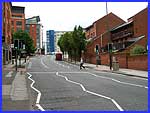  taken
up residence on the site. But our way as we continue our look
at historic Nottingham is to turn our backs on the view above
and head into Hollowstone (left and right) to the Lace Market
area of the city. The name Hollowstone is a reminder of the caves
we first saw at the Brewhouse Yard Museum and more of those caves
are visible in the sandstone here too. They were used not only
for living accommodation but also as tanneries and brew houses
where ale was stored. taken
up residence on the site. But our way as we continue our look
at historic Nottingham is to turn our backs on the view above
and head into Hollowstone (left and right) to the Lace Market
area of the city. The name Hollowstone is a reminder of the caves
we first saw at the Brewhouse Yard Museum and more of those caves
are visible in the sandstone here too. They were used not only
for living accommodation but also as tanneries and brew houses
where ale was stored.
|
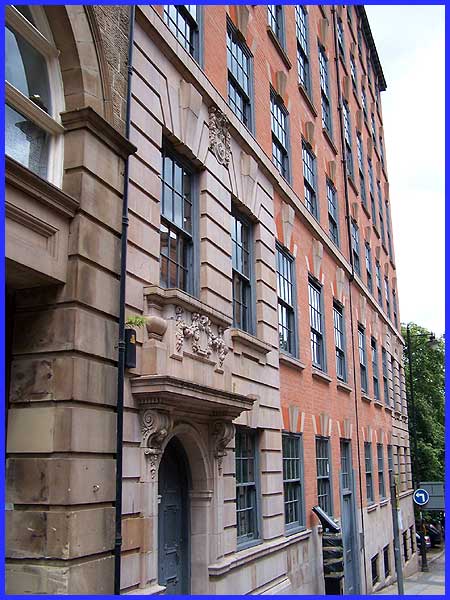
As we ascend the hill towards St Mary's Church, there is also
some impressive architecture to be seen in Hollowstone and this
gives us a foretaste of what to expect in the Lace Market.
|
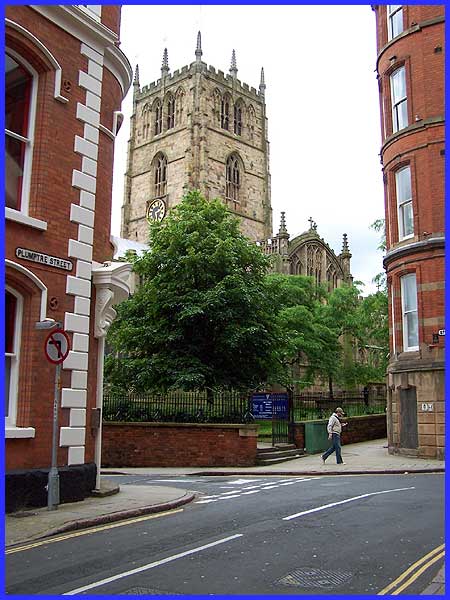
The Church of St. Mary The Virgin stands at the top of Hollowstone
and we shall see more of it later but first we'll turn into Stoney
Street. There is however a good view of the tower of St Mary's
from near the junction of Stoney Street and Plumptre Street where
we can admire what is described as "a masterpiece of medieval
perpendicular architecture". The alleyway between St. Mary's
and the building on the right is Kayes Walk.
|
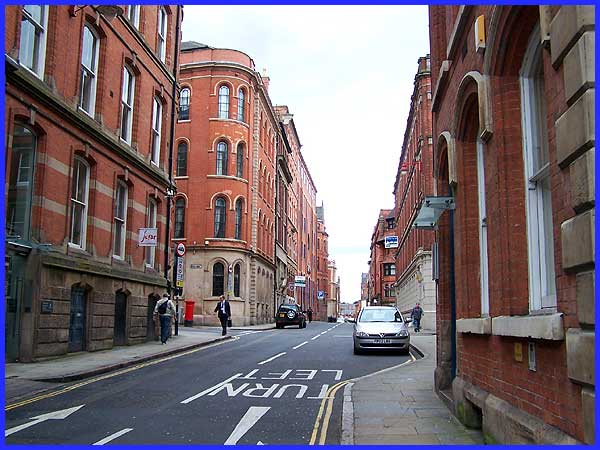
Nottingham of course is associated with a number of well known
names - Robin Hood, Sherwood Forest, Jesse Boot, William Booth
and more recently Torvill and Dean and Brian Clough to name but
a few. But it is also known worldwide for Nottingham Lace and
here on Stoney Street we are in the area of the city known as
the Lace Market. As we walk along the narrow street hemmed in
by the high four storey buildings there is little to prepare
us for what lies just around the corner on the left.
|
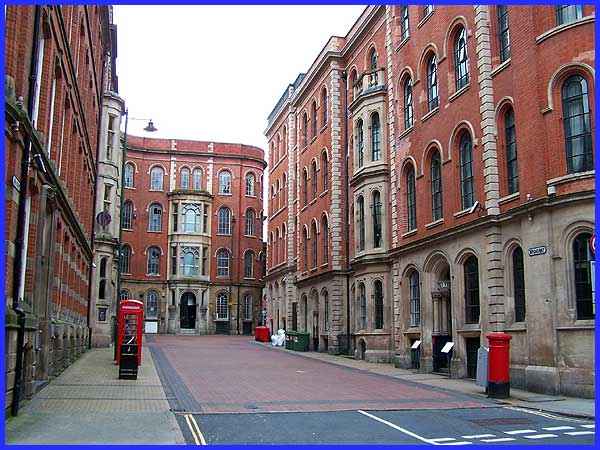
This impressive street is Broadway and as Malcolm Sales writes
in his "100 Walks in Nottinghamshire" book: "Walking
through Broadway in the heart of the old lace area is to experience
the grandeur this industry brought to Nottingham". The buildings
date from the 1850s and if you substitute a view of bustling
people in 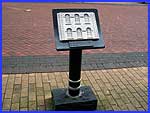 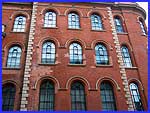 nineteenth century
dress for the street furniture of today, it would be easy to
imagine a scene from any Dickensian novel. It is obvious from
the architecture that the lace trade contributed greatly to the
wealth of the city in this quarter and today strategically placed
podia (example left) with Braille inscriptions and raised plaques
enable even the visually impaired to appreciate the fine features
of the buildings (right). nineteenth century
dress for the street furniture of today, it would be easy to
imagine a scene from any Dickensian novel. It is obvious from
the architecture that the lace trade contributed greatly to the
wealth of the city in this quarter and today strategically placed
podia (example left) with Braille inscriptions and raised plaques
enable even the visually impaired to appreciate the fine features
of the buildings (right).
|
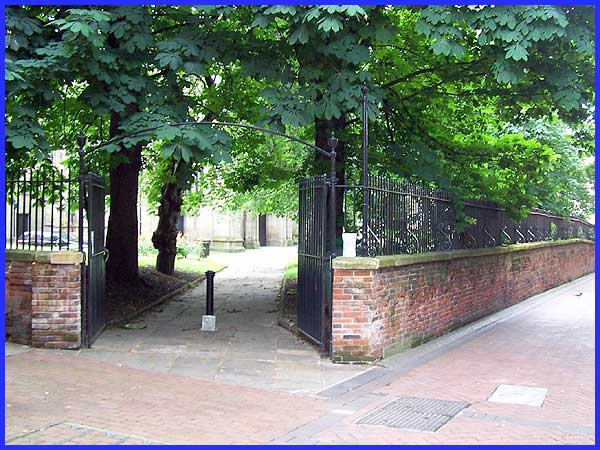
Today the buildings in the vicinity of Broadway are occupied
by a number of bars and small business, some still in the textile
trade but at least one of the them now forms part of a secondary
college. Passing through Broadway 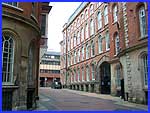  (left) we reach another
narrow street, St. Mary's Gate (right). A left turn here returns
us to St. Mary's Church (above) at the opposite end of Kayes
Walk to the one we saw earlier on Stoney Street. The church is
the ancient Parish Church of Nottingham and evidence exists showing
that prayers have been said on this site for well over a thousand
years. In the next part we shall look a little more closely at
the church before continuing our walk through Historic Nottingham. (left) we reach another
narrow street, St. Mary's Gate (right). A left turn here returns
us to St. Mary's Church (above) at the opposite end of Kayes
Walk to the one we saw earlier on Stoney Street. The church is
the ancient Parish Church of Nottingham and evidence exists showing
that prayers have been said on this site for well over a thousand
years. In the next part we shall look a little more closely at
the church before continuing our walk through Historic Nottingham.
|

